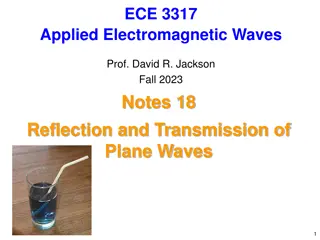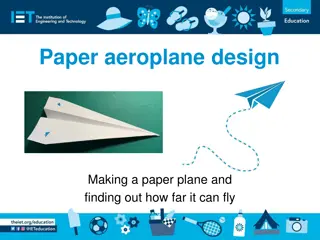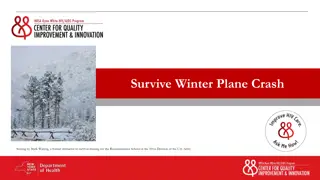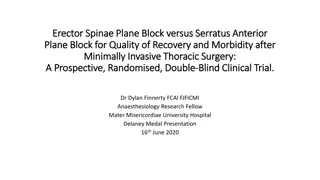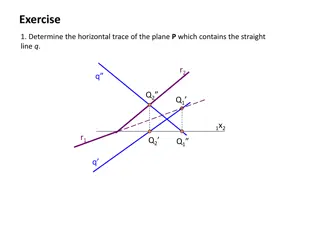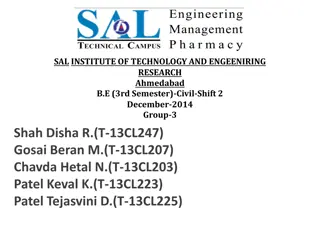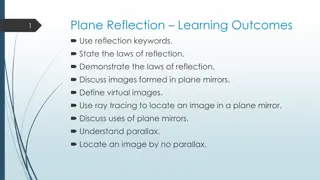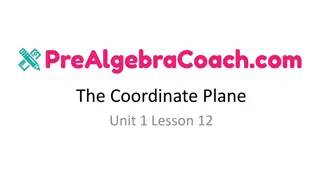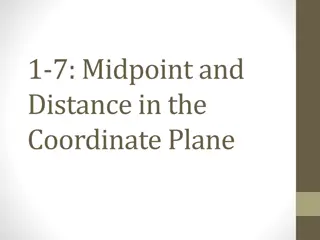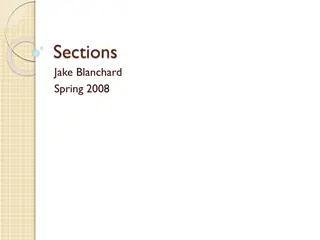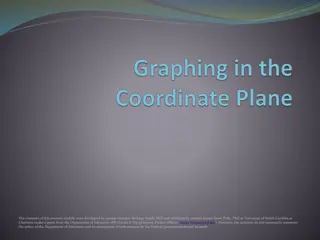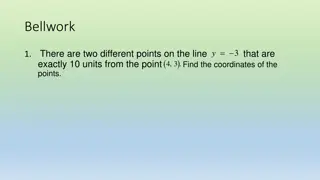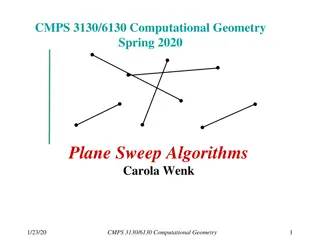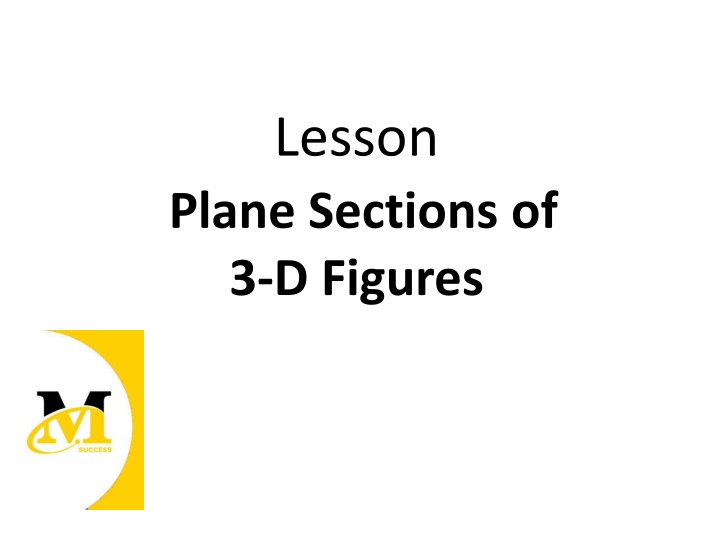
Explore Sections of 3-Dimensional Figures for Learning
Dive into understanding the plane sections of 3-D shapes like prisms and pyramids. Explore the attributes of various geometric figures and solve problems related to slicing shapes in this engaging lesson.
Download Presentation

Please find below an Image/Link to download the presentation.
The content on the website is provided AS IS for your information and personal use only. It may not be sold, licensed, or shared on other websites without obtaining consent from the author. If you encounter any issues during the download, it is possible that the publisher has removed the file from their server.
You are allowed to download the files provided on this website for personal or commercial use, subject to the condition that they are used lawfully. All files are the property of their respective owners.
The content on the website is provided AS IS for your information and personal use only. It may not be sold, licensed, or shared on other websites without obtaining consent from the author.
E N D
Presentation Transcript
Lesson Plane Sections of 3-D Figures
[OBJECTIVE] The student will describe the two-dimensional figures that result from slicing prisms and pyramids.
[MYSKILLS] Attributes of parallelograms, squares, rectangles, prisms, pyramids
[ESSENTIALQUESTIONS] 1. Define plane section. 2. Explain how a plane section is related to the base of a 3-dimensional figure if the cut is parallel to the base. 3. Explain how a plane section of a pyramid is related to the lateral sides if the figure is cut through the vertex.
[Warm-Up] Begin by completing the warm-up for this lesson.
SOLVE Problem Introduction PLANE SECTIONS OF 3-D FIGURES
[LESSON] SOLVE Tyrese is slicing a block of cheese. He is using the cheese along with different fruits to make sculptures of animals. He needs a plane section of cheese in the shape of a parallelogram that is not a rectangle. How should he cut the block of cheese?
[LESSON] SOLVE S Study the Problem Underline the question.
[LESSON] SOLVE Tyrese is slicing a block of cheese. He is using the cheese along with different fruits to make sculptures of animals. He needs a plane section of cheese in the shape of a parallelogram that is not a rectangle. How should he cut the block of cheese?
[LESSON] SOLVE S Study the Problem Underline the question. This problem is asking me to find the way to cut the block of cheese to make a parallelogram that is not a rectangle.
EXPLORE TWO- AND THREE- DIMENSIONAL FIGURES
Explore Two- and Three-Dimensional Figures Take just a moment to look through the figures from Questions 1 5 on the Warm-up page. Decide if the figure is two-dimensional or three- dimensional. Be prepared to explain your answer.
Explore Two- and Three-Dimensional Figures Parallelogram Cube Trapezoid Rectangular Prism Square Pyramid Which figures did you label as two-dimensional? The trapezoid and the parallelogram
Explore Two- and Three-Dimensional Figures Parallelogram Cube Trapezoid Rectangular Prism Square Pyramid Explain your answer. These two figures are flat and they only have length and width, but no depth.
Explore Two- and Three-Dimensional Figures Parallelogram Cube Trapezoid Rectangular Prism Square Pyramid Which figures did you label as three-dimensional? The cube, rectangular prism, and the square pyramid
Explore Two- and Three-Dimensional Figures Parallelogram Cube Trapezoid Rectangular Prism Square Pyramid Explain your answer. These three figures all have bases that show length and width but they also have the third dimension of depth with the height of the figures.
Explore Two- and Three-Dimensional Figures What do you think when you hear the word slice? Cutting something A piece of a whole A slice of bread A slice of cheese An orange slice
Explore Two- and Three-Dimensional Figures Whole: Slice: A wheel of cheese A slice of cheese Using an example of a slice with which you are familiar, sketch the whole, larger item in the box on the left and sketch a slice of that object in the box on the right.
Explore Two- and Three-Dimensional Figures Whole: Slice: A wheel of cheese A slice of cheese In our drawings do we have any two-dimensional figures? Yes, when looking at the shape of the slice after it is taken we see a two-dimensional figure.
Explore Two- and Three-Dimensional Figures Whole: Slice: A wheel of cheese A slice of cheese In our drawings to we have any three-dimensional figures? Yes, the whole solid is three-dimensional.
Explore Two- and Three-Dimensional Figures Whole: Slice: A wheel of cheese A slice of cheese Describe how you found your slice. In the sample answer, instead of cutting a slice that would create two semicircular stacks, the slice was cut similar to a loaf of bread to create a slice that is circular, like its base.
Explore Two- and Three-Dimensional Figures Whole: Slice: A wheel of cheese A slice of cheese We can picture whole items and slices of items in many objects around us. Whenever we look at the shape of the slice, we are seeing the ____________. plane section
PLANE SECTIONS OF RIGHT RECTANGULAR PRISMS PARALLEL AND PERPENDICULAR TO THE BASE
Plane Sections of Right Rectangular Prisms Parallel and Perpendicular to the Base Cut out Figure A following the thin solid line. For now, ignore the dashed lines. A
Plane Sections of Right Rectangular Prisms Parallel and Perpendicular to the Base A What solid do you think will be constructed from this net? A rectangular prism
Plane Sections of Right Rectangular Prisms Parallel and Perpendicular to the Base A When folding, we will create two separate prisms.
Plane Sections of Right Rectangular Prisms Parallel and Perpendicular to the Base Fold at all of the dashed lines on the sides of the rectangle with the letter A. Tape together all of the sides except for the rectangle that is at the bottom of the net before it is folded. This should be the lid of the prism!
Plane Sections of Right Rectangular Prisms Parallel and Perpendicular to the Base Fold at all of the dashed lines on the rectangles and tape together all of the sides except for the one rectangle above the letter A before the net is constructed. This should be the lateral side.
Plane Sections of Right Rectangular Prisms Parallel and Perpendicular to the Base Fold the final flap closed but do not tape this flap shut.
Plane Sections of Right Rectangular Prisms Parallel and Perpendicular to the Base What is the shape of the base of the first solid? Rectangle What is the shape of the base of the second solid? Rectangle
Plane Sections of Right Rectangular Prisms Parallel and Perpendicular to the Base What is the name of the first solid that you built? Rectangular Prism What is the name of the second solid that you built? Rectangular Prism
Plane Sections of Right Rectangular Prisms Parallel and Perpendicular to the Base When we look at these rectangular prisms, what angles are created at the meeting points of all of the edges? 90 degree angles If all of the angles are 90 degree angles, what type of rectangular prisms have we created? Right rectangular prisms
Plane Sections of Right Rectangular Prisms Parallel and Perpendicular to the Base Take a piece of paper and slide it between the lid and the rest of the prism to show our cut into the first prism. If we kept pushing the paper through like a knife, we would cut off the lid. Detach the lid to create a plane section.
Plane Sections of Right Rectangular Prisms Parallel and Perpendicular to the Base What is the relationship between the horizontal slice you created and the base? The slice is parallel to the base because the slice is the same distance away from the base at all points and never cuts through the base.
Plane Sections of Right Rectangular Prisms Parallel and Perpendicular to the Base What is the shape of the plane section, or slice, that we cut from the top of the first box? Rectangle Sketch the shape of the prism s lid.
Plane Sections of Right Rectangular Prisms Parallel and Perpendicular to the Base Take a piece of paper and slide it between open side of the prism to show our cut into the prism. If we kept pushing the paper through like a knife, we would cut off the side. Detach the side to create a plane section.
Plane Sections of Right Rectangular Prisms Parallel and Perpendicular to the Base What is the relationship between the vertical slice you created and the base? The slice is perpendicular to the base because it creates 90 degree angles when the slice meets the base.
Plane Sections of Right Rectangular Prisms Parallel and Perpendicular to the Base What is the shape of the plane section, or slice, that we cut from the side of the second box? Rectangle Sketch the shape of the prism s side.
Plane Sections of Right Rectangular Prisms Parallel and Perpendicular to the Base What observations can you make about the plane section from the first cut? The parallel slice is the same rectangular shape as the bottom or top base.
Plane Sections of Right Rectangular Prisms Parallel and Perpendicular to the Base What observations can you make about the plane section from the second cut? The perpendicular slice is the same rectangular shape as the side of the prism (lateral side).
Plane Sections of Right Rectangular Prisms Parallel and Perpendicular to the Base Conclusions: When we take a horizontal slice parallel to the base of the rectangular prism, the slice is in the shape of a ___________ and is congruent to ____________________________. the base of the rectangular prism rectangle When we take a vertical slice perpendicular to the base of the rectangular prism, the slice is in the shape of a ___________ and is congruent to ____________________________. a side of the rectangular prism rectangle
PLANE SECTIONS OF RECTANGULAR PRISMS ANGLED TOWARDS THE BASE
Plane Sections of Rectangular Prisms Angled Towards the Base Cut out each figure following the thin solid line. For now, ignore the dashed lines and the dark bold lines. B C
Plane Sections of Rectangular Prisms Angled Towards the Base What solid do you think will be constructed from this net? A rectangular prism Let s begin constructing the figures. Fold only the dashed lines and create the rectangular prism that will have different bold lines around the figures.
Plane Sections of Rectangular Prisms Angled Towards the Base
Plane Sections of Rectangular Prisms Angled Towards the Base What is the shape of the base of Figure B? Rectangle What is the shape of the base of Figure C? Rectangle
Plane Sections of Rectangular Prisms Angled Towards the Base What is the name of Figure B that you built? Rectangular Prism What is the name of Figure C that you built? Rectangular Prism
Plane Sections of Rectangular Prisms Angled Towards the Base When we look at these rectangular prisms, what angles are created at the meeting points of all of the edges? 90 degree angles If all of the angles are 90 degree angles, what type of rectangular prisms have we created? Right rectangular prisms
Plane Sections of Rectangular Prisms Angled Towards the Base What do you notice about the prisms? They have bold lines around them as if a slice is being cut into them.
Plane Sections of Rectangular Prisms Angled Towards the Base Take your scissors and carefully cut the dark bold line until each prism has been separated into separate pieces. Using the extra paper given, use one of the pieces for tracing.

